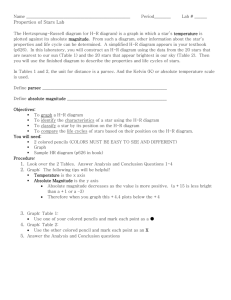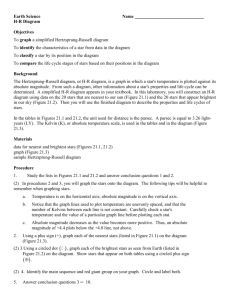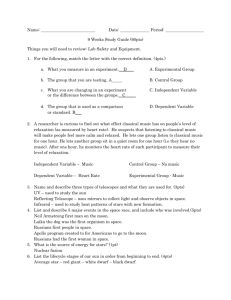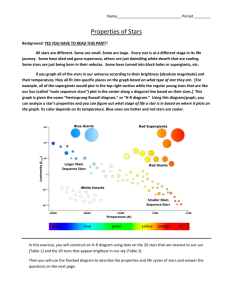H-R Diagram: Properties of Stars Lab Activity
advertisement
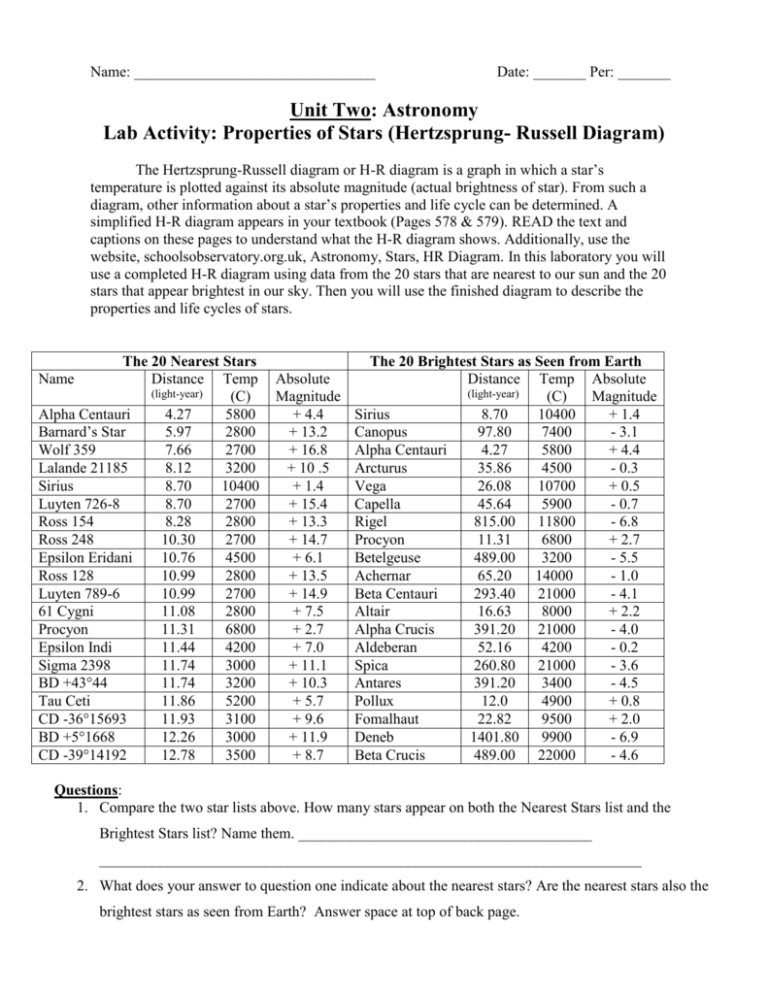
Name: ________________________________ Date: _______ Per: _______ Unit Two: Astronomy Lab Activity: Properties of Stars (Hertzsprung- Russell Diagram) The Hertzsprung-Russell diagram or H-R diagram is a graph in which a star’s temperature is plotted against its absolute magnitude (actual brightness of star). From such a diagram, other information about a star’s properties and life cycle can be determined. A simplified H-R diagram appears in your textbook (Pages 578 & 579). READ the text and captions on these pages to understand what the H-R diagram shows. Additionally, use the website, schoolsobservatory.org.uk, Astronomy, Stars, HR Diagram. In this laboratory you will use a completed H-R diagram using data from the 20 stars that are nearest to our sun and the 20 stars that appear brightest in our sky. Then you will use the finished diagram to describe the properties and life cycles of stars. The 20 Nearest Stars Distance Temp (light-year) (C) Alpha Centauri 4.27 5800 Barnard’s Star 5.97 2800 Wolf 359 7.66 2700 Lalande 21185 8.12 3200 Sirius 8.70 10400 Luyten 726-8 8.70 2700 Ross 154 8.28 2800 Ross 248 10.30 2700 Epsilon Eridani 10.76 4500 Ross 128 10.99 2800 Luyten 789-6 10.99 2700 61 Cygni 11.08 2800 Procyon 11.31 6800 Epsilon Indi 11.44 4200 Sigma 2398 11.74 3000 BD +43°44 11.74 3200 Tau Ceti 11.86 5200 CD -36°15693 11.93 3100 BD +5°1668 12.26 3000 CD -39°14192 12.78 3500 Name Absolute Magnitude + 4.4 + 13.2 + 16.8 + 10 .5 + 1.4 + 15.4 + 13.3 + 14.7 + 6.1 + 13.5 + 14.9 + 7.5 + 2.7 + 7.0 + 11.1 + 10.3 + 5.7 + 9.6 + 11.9 + 8.7 The 20 Brightest Stars as Seen from Earth Distance Temp Absolute (light-year) (C) Magnitude Sirius 8.70 10400 + 1.4 Canopus 97.80 7400 - 3.1 Alpha Centauri 4.27 5800 + 4.4 Arcturus 35.86 4500 - 0.3 Vega 26.08 10700 + 0.5 Capella 45.64 5900 - 0.7 Rigel 815.00 11800 - 6.8 Procyon 11.31 6800 + 2.7 Betelgeuse 489.00 3200 - 5.5 Achernar 65.20 14000 - 1.0 Beta Centauri 293.40 21000 - 4.1 Altair 16.63 8000 + 2.2 Alpha Crucis 391.20 21000 - 4.0 Aldeberan 52.16 4200 - 0.2 Spica 260.80 21000 - 3.6 Antares 391.20 3400 - 4.5 Pollux 12.0 4900 + 0.8 Fomalhaut 22.82 9500 + 2.0 Deneb 1401.80 9900 - 6.9 Beta Crucis 489.00 22000 - 4.6 Questions: 1. Compare the two star lists above. How many stars appear on both the Nearest Stars list and the Brightest Stars list? Name them. _______________________________________ ________________________________________________________________________ 2. What does your answer to question one indicate about the nearest stars? Are the nearest stars also the brightest stars as seen from Earth? Answer space at top of back page. 2._________________________________________________________________________________ _____________________________________________________________ 3. A star located in the lower right portion of the H-R diagram is cool and dim. What are the characteristics (Temp. and Absolute Magnitude) of a star in the upper left of the diagram? In the upper right? Upper left: ______________________________________________________________ Upper right: _____________________________________________________________ 4. Refer to pages 578 and 579 of your textbook. To which group does most of the stars on your diagram belong? _______________________________________________________________________ 5. According to your diagram and the textbook diagram, are any of the 20 nearest or 20 brightest stars white dwarfs? What is the evidence for your answer? ________________________________________________________________________ 6. Our sun has a temperature of 5,800 C and an absolute magnitude of + 4.7. To what group of stars does the sun belong? ________________________________________________________________________ 7. Betelgeuse is 489 light-years away and has a surface temperature of only 3200 K yet Betelgeuse is one of the brightest stars as seen from Earth. What does this indicate about the size of Betelgeuse? Why is your answer supported by the location of Betelgeuse on the H-R diagram? ________________________________________________________________________ ________________________________________________________________________ 8. On your diagram, there is another star that is plotted near Betelgeuse. What is the name of the star and what kind of star is it? _______________________________________________________________________ 9. Compare our sun with the red supergiant star Antares. Which star is further along in its life cycle? How do you know?


